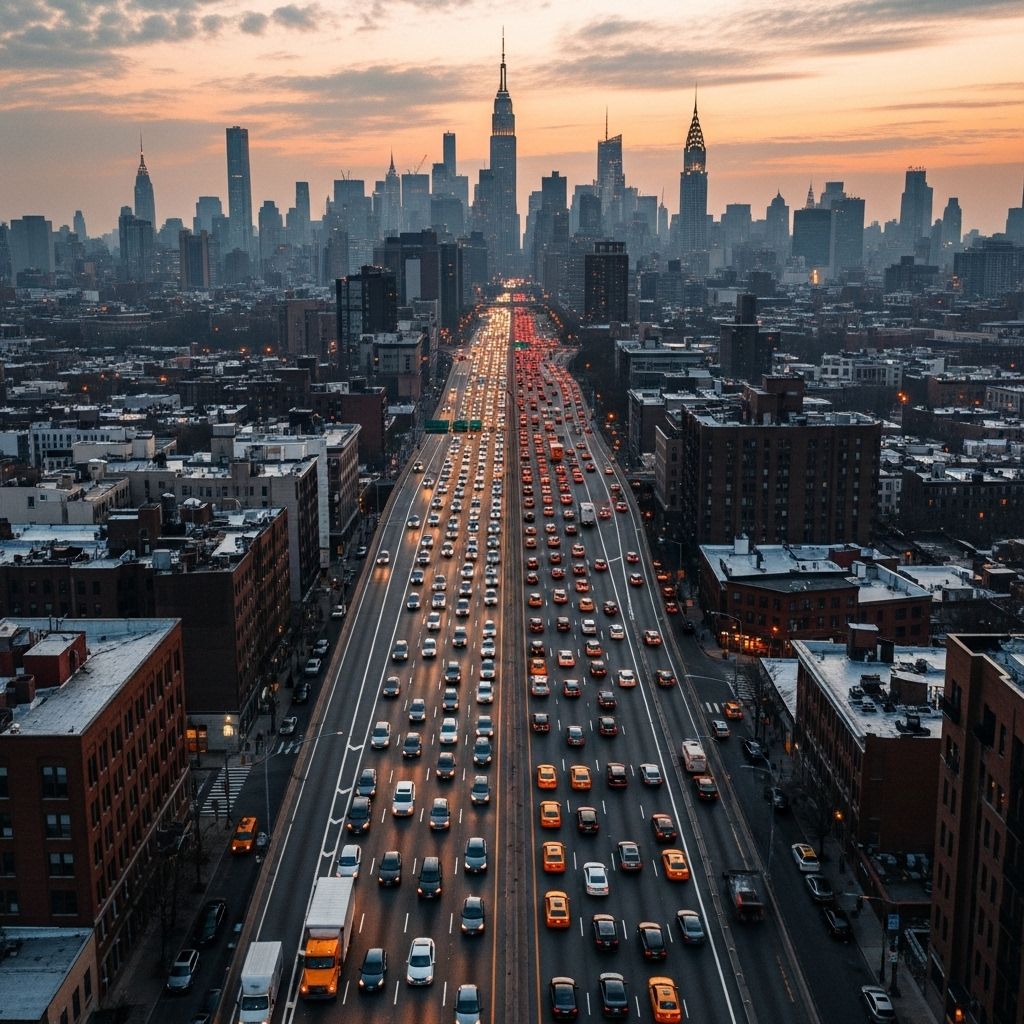How Cars Conquered New York City: A Journey Through Urban Transformation
From foot traffic to traffic jams: tracing the century-long journey of cars as they transformed New York City's streets, spaces, and urban life.

New York City, once famed for its bustling sidewalks, lively horse-drawn carriages, and complex streetlife, underwent a dramatic transformation during the 20th century. Over the course of decades, cars redefined public spaces, altering the physical and social fabric of the city. This article traces the historic ascent of automobiles in New York and how their dominance shaped, and in some ways, limited the city’s possibilities for public life, mobility, and environmental health.
The Era Before Cars: Streets for People
At the turn of the 20th century, New York City’s streets were vibrant, multipurpose spaces filled with pedestrians, street vendors, children at play, horse-drawn carts, and emerging public transit. Streets were not just conduits for movement—they were communal spaces for social interaction and commerce.
Key features of pre-car streets:
- Streets served as marketplaces, gathering spaces, and play areas.
- Sidewalks were often overflowing, merging seamlessly into carriageways.
- Horse-drawn vehicles and electric streetcars provided mobility, but at speeds and scales compatible with pedestrian activity.
- Bicycles also featured prominently in city life, sharing roadspace with other users.
The Arrival and Proliferation of Automobiles
The early 20th century saw the automobile rapidly emerge as a symbol of prosperity and modernity. In the beginning, cars were rare luxury items, but by the 1920s, their numbers soared as Fordist mass production made them more accessible to the wider public.
- Road fatalities and traffic congestion became immediate concerns with rising automobile use.
- City streets, previously designed around people, became sites of contest over traffic rules, safety, and speed.
- Automotive interests lobbied the city government for street redesigns that prioritized cars over other users.
Urban Infrastructure Adaptations
In response to increasing numbers of cars, New York initiated sweeping changes to its physical layout:
- Widening of avenues and straightening of street grids for automobile traffic flow.
- Introduction of traffic signals, stop signs, and parking regulations to manage the chaos of early car culture.
- Asphalt replaced cobblestones, making roads smoother and more suitable for cars’ wheels.
- Construction of urban highways, bridges, and tunnels fundamentally altered neighborhoods and access patterns.
Suppression of Street Life and Non-Car Uses
As cars became prevalent, alternative uses of streets were pushed aside. Activities and people that interrupted car movement were increasingly marginalized, with policy and policing to respond to the ‘menace’ of jaywalking and improvised street play.
- The term ‘jaywalking’ was popularized as a pejorative for pedestrians who crossed roads outside regulated intersections.
- Children’s street games and informal vendors were policed and sometimes criminalized for obstructing traffic.
- Bike use dropped drastically as roads became more dangerous and less welcoming for non-drivers.
Robert Moses and the Age of Urban Renewal
By the mid-twentieth century, urban planner Robert Moses dominated New York’s development philosophy. He championed the automobile at every turn:
- Construction of extensive parkways, bridges, and expressways bisected long-standing communities.
- Streets, squares, and even parks were redesigned for car access or parking.
- Dense public transit networks and walkable neighborhoods were deprioritized in favor of car-centric mobility.
These changes led to a physical and psychological separation between city dwellers and their public spaces. ‘White flight’ and suburbanization were accelerated as highways made it easier to live far from the city center.
Table: Major Moses-Era Expressway Projects
| Project Name | Year | Impacts |
|---|---|---|
| Cross Bronx Expressway | 1948–1972 | Displaced thousands of residents, divided neighborhoods |
| Brooklyn-Queens Expressway | 1940s–1960s | Created barriers between areas, increased traffic flows |
| West Side Highway | 1930s–1973 | Directed vehicle traffic along the Hudson waterfront |
Parking: The Unseen Engine of Car Culture
With more cars came demands for parking. The city’s regulatory code required generous off-street parking for new developments, incentivizing even further car ownership and reshaping street design.
- On-street parking replaced many former trolley tracks, bike lanes, and loading areas.
- Business districts and residential zones allocated substantial curb space for private vehicle storage.
- Paved lots and parking garages emerged as defining features of the cityscape, often replacing old buildings or green spaces.
Public Backlash and Calls for an Alternative
By the 1960s and ’70s, the cumulative effects of car-centric development—congestion, pollution, displacement, and the reduction of public space—sparked grassroots opposition. Community activists, most famously Jane Jacobs, challenged Moses’ vision and lobbied for a more humane city design:
- Plans for expressways that would have erased neighborhoods such as SoHo and Chinatown were defeated by local resistance.
- Movements advocated for the preservation of public squares and parks, prioritizing people over cars.
The Environmental and Social Costs of Car Domination
The era of uncontrolled car expansion created lasting challenges for New York:
- Air pollution and noise became pervasive urban problems.
- Traffic deaths and injuries rose sharply, with pedestrians and cyclists at greatest risk.
- Social life diminished as public spaces shrank and streets grew less hospitable to non-drivers.
- Health and equity disparities worsened as car infrastructure destroyed affordable housing and isolated marginalized communities.
Recent Shifts: Reclaiming the Streets and Tackling Congestion
In the 21st century, city leaders and planners began rethinking New York’s relationship with the car, launching projects to reclaim space for public life and curb the automobile’s dominance.
Major Policy Interventions
- Pedestrian Plazas: Closing off segments of Broadway in Times Square and Herald Square turned congested intersections into award-winning public spaces.
- Protected Bike Lanes: Miles of new lanes were constructed, making cycling safer and increasing ridership citywide.
- Slow Streets and Open Streets programs: Launched in response to Covid-19, entire roads
References
- https://www.tomtom.com/newsroom/explainers-and-insights/the-data-behind-nyc-s-congestion-pricing-success/
- https://abc7ny.com/post/nyc-traffic-deaths-officials-say-city-has-seen-fewest-fatalities-recorded-history-far-2025/16920646/
- https://www.nyc.gov/html/dot/html/pr2025/vision-zero.shtml
- https://www.governor.ny.gov/news/less-traffic-safer-streets-summer-comes-end-governor-hochul-highlights-continued-success
- https://data.cityofnewyork.us/Transportation/Automated-Traffic-Volume-Counts/7ym2-wayt
- https://www.nyc.gov/site/nypd/stats/traffic-data/traffic-data-archive-2025.page
- https://c2smarter.engineering.nyu.edu/manhattan-congestion-tracker/
- https://vzv.nyc
Read full bio of medha deb












